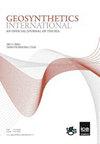Centrifuge modeling of levees with geocomposite chimney drain subjected to flooding
IF 2.8
2区 工程技术
Q2 ENGINEERING, GEOLOGICAL
引用次数: 0
Abstract
The objective of the present study is to evaluate the performance of a levee section when subjected to flooding and subsequent seepage through centrifuge model tests. For this, six centrifuge model tests were conducted on a 240 mm high levee model at 30g in a 4.5 m radius large beam geotechnical centrifuge available at the Indian Institute of Technology Bombay, India. A custom-developed flooding simulator is employed to induce identical flood rates on the upstream side of the levee models. Further, using (a) geocomposite (GC) and (b) sand-sandwiched geocomposite (SSGC) as internal chimney drain, the suitability of GC material for dissipation of pore-water pressure (PWP) is also studied. The results of the centrifuge tests are presented and discussed in terms of the development of upstream flood function, subsequent PWP development within the levee body, and the surface settlements observed at the levee's crest. Further, the influence of an internal chimney drain, the material used for its construction, and its type and composition on the seepage response of the levee is discussed in detail. The performance GC chimney drain placed within the levee section subjected to flooding-induced seepage is compared with a conventional sand chimney drain. It is observed that a GC-based chimney drain with sand cushioning on both sides in the horizontal portion of the chimney drain performs well. Further, digital image analysis of SEM micrographs of exhumed GC after centrifuge tests and the analyzed PWP data during sustained flooding-induced seepage is found to corroborate well.带有土工复合材料烟囱排水口的堤坝受洪水侵袭时的离心建模
本研究的目的是通过离心机模型试验,评估堤坝在遭受洪水和随后的渗流时的性能。为此,在印度孟买印度理工学院现有的半径为 4.5 米的大梁岩土离心机中,对 240 毫米高的堤坝模型进行了六次离心机模型试验,试验重量为 30 克。采用定制开发的洪水模拟器在堤坝模型的上游侧诱发相同的洪水速率。此外,还使用(a)土工复合材料(GC)和(b)砂砂复合材料(SSGC)作为内部烟囱排水管,研究了土工复合材料消散孔隙水压力(PWP)的适用性。离心机试验的结果从上游洪水功能的发展、随后堤身内部孔隙水压力的发展以及在堤顶观察到的表面沉降等方面进行了介绍和讨论。此外,还详细讨论了内部烟囱排水沟、建造烟囱排水沟的材料及其类型和成分对堤坝渗流响应的影响。将置于堤段内的 GC 型烟囱排水沟与传统的砂质烟囱排水沟的性能进行了比较。结果表明,基于 GC 的烟囱排水系统在水平部分的两侧都有沙子缓冲,性能良好。此外,对离心机试验后挖出的 GC 的扫描电镜显微照片进行的数字图像分析,以及对持续洪水诱导渗流期间的 PWP 数据进行的分析,也发现两者之间有很好的吻合。
本文章由计算机程序翻译,如有差异,请以英文原文为准。
求助全文
约1分钟内获得全文
求助全文
来源期刊

Geosynthetics International
ENGINEERING, GEOLOGICAL-GEOSCIENCES, MULTIDISCIPLINARY
CiteScore
6.90
自引率
20.00%
发文量
91
审稿时长
>12 weeks
期刊介绍:
An online only, rapid publication journal, Geosynthetics International – an official journal of the International Geosynthetics Society (IGS) – publishes the best information on current geosynthetics technology in research, design innovation, new materials and construction practice.
Topics covered
The whole of geosynthetic materials (including natural fibre products) such as research, behaviour, performance analysis, testing, design, construction methods, case histories and field experience. Geosynthetics International is received by all members of the IGS as part of their membership, and is published in e-only format six times a year.
 求助内容:
求助内容: 应助结果提醒方式:
应助结果提醒方式:


